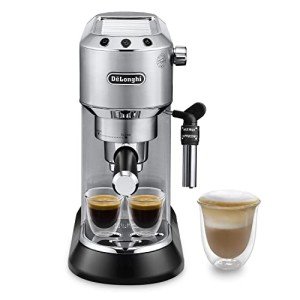The History Of Home Use Espresso Machines

Home Use Espresso Machines: A Comprehensive Guide
Espresso machines have actually ended up being a staple in numerous homes as coffee lovers look for to replicate café-quality brews in the comfort of their cooking areas. The rise in popularity has actually resulted in a varied market filled with different designs, features, and costs. This short article aims to provide a useful overview of home use espresso machines, assisting readers navigate their alternatives efficiently.
Understanding Espresso Machines
Espresso machines work by forcing hot water through finely-ground coffee under high pressure, resulting in a focused coffee drink called espresso. There are a number of kinds of espresso machines categorized based upon their developing techniques and level of automation. The most typical types include:
- Manual Espresso Machines: These require the user to control the pressure and water flow, enabling for a more hands-on coffee-making experience.
- Semi-Automatic Espresso Machines: These use automatic control over water pressure, while the user by hand grinds and tamps the coffee.
- Automatic Espresso Machines: With the push of a button, these machines automatically manage the flow of water, making it simpler to brew espresso with constant results.
- Super-Automatic Espresso Machines: These all-in-one machines handle grinding, tampering, developing, and even milk frothing, making them perfect for users trying to find benefit.
- Pill or Pod Machines: These use pre-packaged coffee pods to develop espresso with minimal effort, but they limit option in developing techniques and flavors.
Table: Comparison of Espresso Machine Types
| Type | Control Level | Reduce of Use | Cleaning Level | Perfect For |
|---|---|---|---|---|
| Manual | User-controlled | Moderate | High | Coffee purists |
| Semi-Automatic | Partial automation | Moderate | Moderate | Home baristas |
| Automatic | Completely automated | Easy | Low | Hectic people |
| Super-Automatic | Totally automated | Very simple | Really low | Convenience applicants |
| Capsule/Pod | Totally automated | Very simple | Really low | Casual drinkers |
Secret Features to Consider
When picking a home use espresso machine, it's necessary to think about various functions that can substantially affect the quality of espresso and user experience.
- Pressure: Look for machines that offer a minimum of 9 bars of pressure, as this is thought about optimal for brewing espresso.
- Boiler Systems: Single vs. dual boiler systems figure out temperature level stability and the ability to brew espresso and steam milk all at once.
- Grinder: Integrated grinders permit freshly ground coffee, which enhances flavor. Consider machines with adjustable grind settings.
- Milk Frother: For those who enjoy coffees and lattes, an integrated steam wand or automatic frother is vital.
- Size and Design: Consider your cooking area area and aesthetic choices. Machines can be found in numerous sizes, from compact to large setups.
- Rate: Home espresso machines can vary from a few hundred to a number of thousand dollars, so it's essential to develop a budget before checking out options.
Advantages and disadvantages of Home Use Espresso Machines
| Pros | Cons |
|---|---|
| Benefit of brewing coffee in the house | Initial investment can be high |
| Quality of espresso is typically superior | Requires some skill, especially with manual machines |
| Capability to experiment with tastes | Upkeep and cleaning can be labor-intensive |
| Can conserve money in the long run | Not all machines will suit every coffee preference |
Upkeep and Cleaning Tips
Preserving an espresso machine is crucial for extending its life and ensuring constant brew quality. Here are some useful tips:
- Regular Descaling: Minerals from water can develop in the machine. Descale every 1-3 months, depending upon water solidity.
- Daily Cleaning: Rinse portafilters, baskets, and steam wands after each use to avoid coffee oils from constructing residue.
- Use Filtered Water: This can help in reducing mineral buildup and enhance the taste of coffee.
- Change Gaskets and Seals: These parts might wear gradually and ought to be replaced to maintain pressure and performance.
- Check out the Manual: Each machine has specific care directions; following these will guarantee durability.
Frequently Asked Questions About Home Use Espresso Machines
Q1: What is the best budget espresso machine?The best budget espresso machine often depends on specific needs, however models like the DeLonghi EC155 or the Breville Bambino are popular among users for offering excellent worth. Q2: How long do home espresso machines usually last?With correct upkeep, home espresso machines can last anywhere from 5 to 15 years, depending on the quality of the machine and frequency of use. Q3: Can I make cappuccinos and lattes with any espresso machine?While most espresso machines can make cappuccinos and lattes, having a reliable
steam wand or frother is essential for attaining the ideal milk texture.
Q4: Are super-automatic machines worth the investment?For those who focus on benefit and fast developing, super-automatic machines can be worth the financial investment, though they might do not have some customizability in brew strength and taste. Q5: What kinds of coffee beans are best for espresso?While individual preference plays a function, beans identified as" espresso "blends are generally roasted darker, producing rich flavors and a velvety texture when brewed.
Purchasing a home espresso machine can transform the daily coffee regimen into something unique, raising home brews to café quality. By understanding the various kinds of machines, key functions to consider, maintenance requirements, and weighing the
benefits and drawbacks, customers can make educated choices that fit their private preferences. As Pump Espresso Machines continues to grow, no matter the option, every brew can be a scrumptious experience waiting to be savored.

